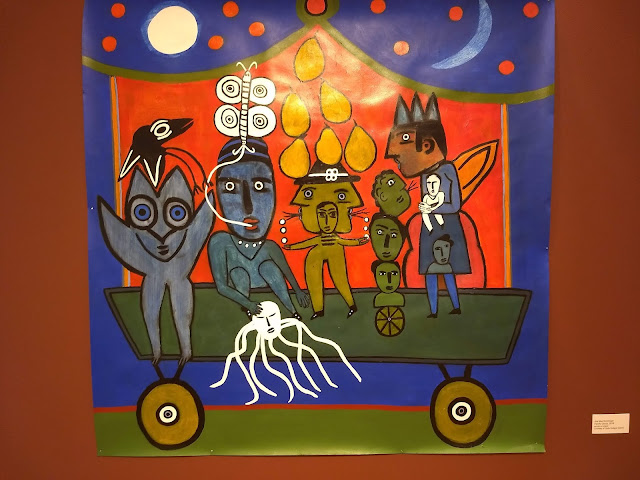A ferry arriving in Seattle from either Bainbridge Island or Bremerton.
 |
| Here you can see the Space Needle on the left and on the far right is Smith Tower (tiny little white building). We've been to both. |
 |
| Here I am, looking at yarn. I managed to restrain myself from buying yet more yarn. |
 | |
| On the island tour. A view of downtown Seattle. The wood sticking out of the water in the foreground is what's left of an original boat pier from the late 1800's. |
 |
| Beautiful and restful woods at the memorial. |
 |
| This harbor was where the ferry dock was at the time of WWII and the removal of the Japanese from the island. |
There are pictures from the newspaper at the time that show the Japanese boarding the ferry. Our guide pointed out a picture of a two year old boy and said that the boy's family came back to the island and the boy grew up to become a dentist. That man was our guide's dentist. Many people on Bainbridge did the right thing and took care of the homes and businesses and farms of the Japanese prisoners while they were gone so that they would have a home to return to. Unfortunately, not everyone did so, some of the homes were destroyed and/or stolen by some of the inhabitants of the island.
 |
| Don's new camera has a great zoom lens. This was taken from Driftwood Beach. |
After the tour we visited the history museum.
 |
| Just one section of a 30 foot chamber used for applying creosote to wood. |
A before and after look at the graduating class of 1942 and 1943. All the Japanese are gone from the 1943 graduating class, they're all in internment camps in California.
We also visited the small art museum. There were at least four exhibits by local artists and we loved them all. This artist, Joe Max Emminger, really caught our eye and imagination.
I really loved the exhibition "An Abecedarian of Artist's Books" and wish I had pictures but here is a link:
https://www.biartmuseum.org/artists-book-collection/
We spent some time at the brew pub next to the museum, drinking beers and playing cards while sitting outside, what could be better? We then went for a walk along the waterfront.
 |
| Crossing over a little creek on the way to the waterfront park. |
We then walked back to the ferry terminal and waited for 30 minutes because the ferry was late.
 |
| Cars waiting to board the ferry. |
 |
| The angled building to the left of the black building is supposed to evoke the hand on hip pose of Audrey Hepburn in "Breakfast at Tiffany's". |













































No comments:
Post a Comment